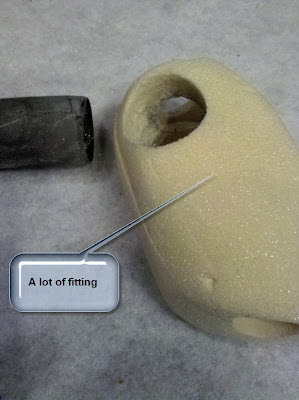Aerodynamics and a Tail
One interesting aspect of aerodynamics shapes is that the tail shape can be as important as the frontal shape. For instance, a square plate moving through air has less aerodynamic efficiency (Cd -- Coefficiet of drag) as compared to the same size square plate with a long tail.
I decided to add a more efficient tail to the handcycle. Of course I am guessing that the shape I produce for the tail, is indeed more efficient as compared to not adding the shape. I could be wrong! For my bike, the tail is relatively short and therefore, the tail will not reduce drag very much as compared to a recumbent bike with a tailbox. Here is an example of an efficient tailbox:
Since my ams are moving, I cannot build something as efficient as above and my interest is not in doing so.
On the otherhand, a $150 TT (time trial) helmet could save me 4 seconds per 40K...
Or $10-$15 worth of carbon fiber may save me more... Here is the tail before trimming the trailing edge:
 |
| After - New Tail - Side View |
 |
| After - Top/Rear tail View |
 |
| Before Tail added |
Design, Power and Speed
A friend and I rode together -- he on a very nice road bike and I rode on a 3-wheeled handcycle. We maintained just about 20mph over a 20 mile ride. I was pushing quite hard. He had a power meter that kept the stats for the duration of the ride. At the end of the ride, he found that he averaged just over 200 watts output for the duration. Of course, I wondered what my power output averaged. There is a site that does calculations based upon SRM Power Measuring Cranks. There is no 3-wheeled recumbent bikes listed, but I presume that I had a very similar power output to a racing bike due to my 3-wheels.
This raises a question -- what do I expect for speed with the new bike at a reduced wattage of output (I cannot hold 200 watts for 5 or 6 hours)? The calculator's result for a lowracer:
If this bike can achieve 22.3 mph average (and 19.5 mph on a 0.5% grade) with my power output at 160 watts, I will indeed by happy with the results.
BTW, by choosing the "Lowracer with streaming tailbox" type of recumbent on the calculator, the speed increases to 23.3 mph. Since my tail is much shorter, I would expect only a percentage of that increase in speed as compared to not having a tail. That still calculates out to about 20-40 seconds deduction over 40K. Not bad if it holds true!
















































